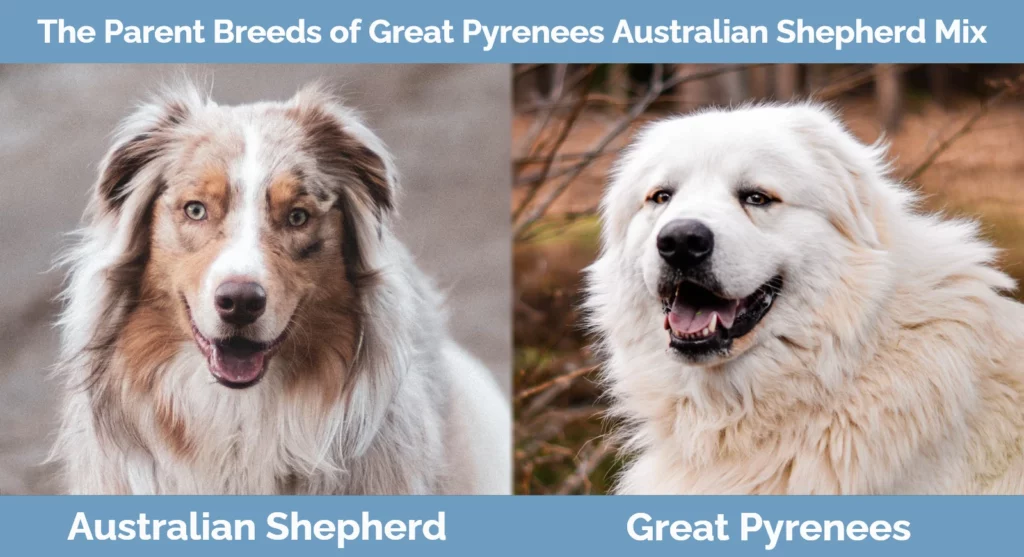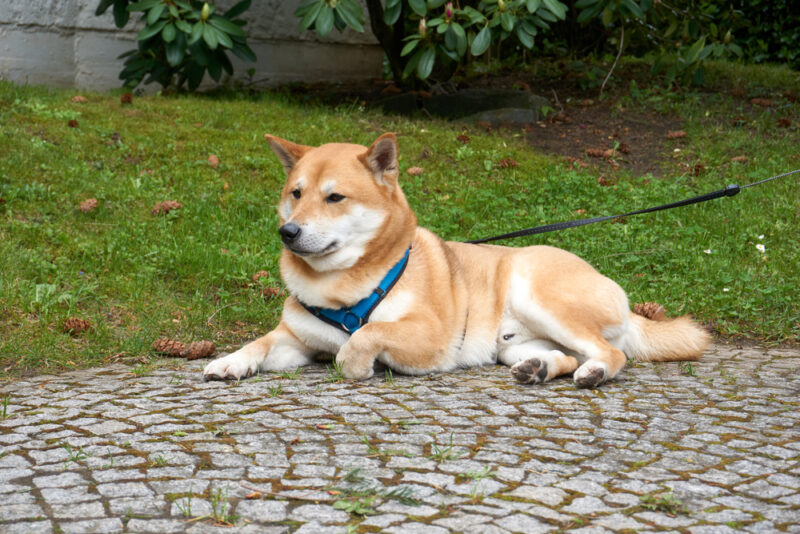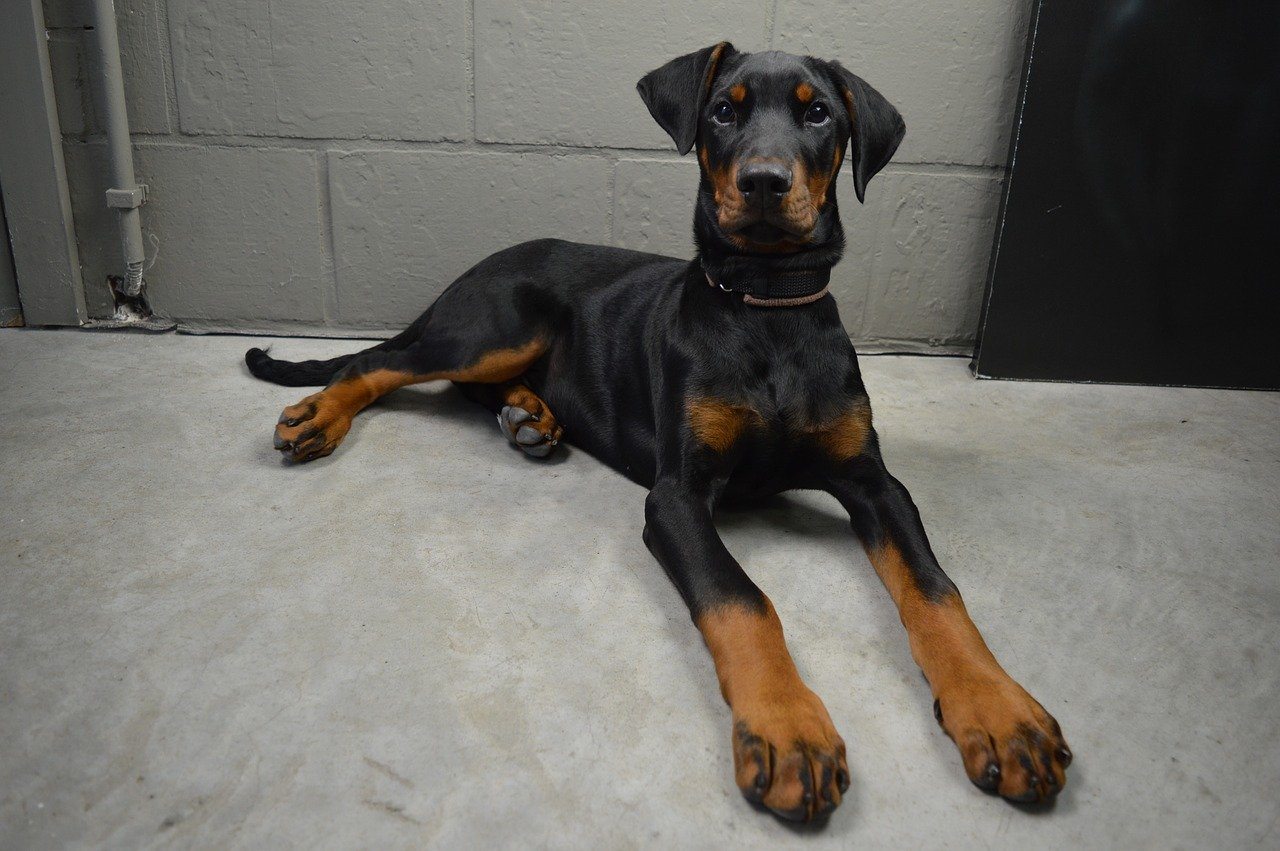Great Pyrenees Australian Shepherd Mix Pet Breed Info: Pictures, Temperament & Traits

Updated on

| Height: | 25–32 inches |
| Weight: | 50–110 pounds |
| Lifespan: | 10–15 years |
| Colors: | White, cream, brindle, tan, double-color, tri-color |
| Suitable for: | Families with older kids, active families, owners with large yards |
| Temperament: | Loyal, intelligent, protective, affectionate |
The Great Pyrenees Australian Shepherd Mix is a breed that combines two popular dog breeds: the Great Pyrenees and the Australian Shepherd. This breed, sometimes also known as the Aussie Pyrenees, has a rich background thanks to its parentage that combines traits from each parent breed. The Aussie Pyrenees then makes a great dog for people who love spending time outdoors and those looking for a fantastic watchdog.
Keep reading to learn everything you’ve ever wanted to know about this breed and how to decide if it’s the perfect breed for your family.
Great Pyrenees Australian Shepherd Mix Puppies
The exact price of your puppy will depend on many factors, including its pedigree, coloring, markings, and the reputation of the breeder. A pup that’s coming from a champion bloodline will be on the higher end of the price spectrum.
You may get lucky and find an Aussie Pyrenees at a local animal shelter, too.
3 Little-Known Facts About the Great Pyrenees Australian Shepherd Mix
1. You never know what you’re going to get.
Since the Aussie Pyrenees is a crossbreed, its appearance can change vastly depending on the dominant genes that it inherited from its parents. Even after its born, you still will not know what it will look like as an adult because some of its genes will only become noticeable after it grows. What often happens is that an Aussie Pyrenees may look like one of its parents as a puppy, but as it grows, it takes on more of the other parent’s qualities.
2. They need a lot of exercise
As you’ll find out later in our article, Aussie Pyrenees dogs need a lot of exercise, which is one of the reasons that this breed isn’t a great fit for every family. The parent breeds of the Aussie Pyrenees were bred to be working dogs, and even if your pup isn’t going to be herding livestock or pulling carts of milk, they still retain that working dog mentality. You should be prepared to exercise this breed for at least an hour every day.
3. They make great protectors.
This breed makes a fantastic guard dog due not only to its large size but its willingness to protect its family members. Don’t let that confuse you into thinking that Aussie Pyrenees dogs are aggressive and unsafe to have around children. This breed is very friendly and caring and will do well in environments with children so long as the children know boundaries and are always supervised when around your dog.
The Aussie Pyrenees may have gotten its protector qualities from its Great Pyrenees lineage. This breed was the Royal Dog of France as they guarded the chateau during King Louis XIV’s reign.

Temperament & Intelligence of the Great Pyrenees Australian Shepherd Mix 🧠
Since the Aussie Pyrenees is a hybrid breed, you can get a general idea of its temperament by looking at its parents. This breed often has a happy mix of characteristics from both of its parents.
The Great Pyrenees is a smart, patient, and loyal breed. They tend to be very calm but aren’t afraid to spring into action if they sense a threat. They make fantastic companion pets, enjoy quiet time with their families, and thrive in an environment that’s predictable.
The Great Pyrenees is a working dog breed that has had a lot of different jobs throughout history, including protecting flocks, acting as sled dogs, and pulling carts.
They are highly intelligent but can be difficult to train as they can have very independent personalities. It is essential to train these dogs, however, as they grow to be quite large, and establishing obedience when they’re full grown will be physically demanding and difficult.
The Australian Shepherd is a breed of herding dog that was known purely as a working dog for over a century. It wasn’t until the mid-20th century that the breed became popular in rodeos and horse shows that eventually helped make the Aussie a more mainstream breed.
Aussies are known to be intelligent, loyal, and protective dogs. Though they are now predominantly bred to be pets, they still maintain a herding instinct that manifests in them trying to herd children or other household pets. They are very active and can become destructive if they’re not given opportunities for exercise.
Knowing what you know now about the Aussie Pyrenees’ heritage, you can make some basic assumptions about the breed.
They are affectionate, loyal, and protective. They make fantastic guard dogs but love spending time with their humans, too. They can be very friendly and sociable, provided you socialize them well when they’re young.
The Aussie Pyrenees can be aggressive, but this aggression can be trained out of them.
Are These Dogs Good for Families? 🏡
The Aussie Pyrenees can make a great family pet, but if you have small children, you need to be careful. They certainly can be great with children and make a lovely playmate for your kids, but they need proper training.
This is a large breed dog and can easily harm a child without meaning to. You might consider holding off adopting an Aussie Pyrenees until your children are a bit older when they understand boundaries and how to respect and treat a family pet.
Does This Breed Get Along with Other Pets? 🐶 😽
With proper training, an Aussie Pyrenees can get along with other household pets. If they are brought up to see the other animals in the household as family members, they might even love and protect them the same way they do with their human family. Since this breed has an innate herding instinct, you might even find it trying to herd the other pets of your home.
You must introduce your Aussie Pyrenees to the other animals in the house slowly. It’s also best if they’re introduced when they’re young if possible.
Things to Know When Owning a Great Pyrenees Australian Shepherd Mix:
Food & Diet Requirements 🦴
Your Aussie Pyrenees will need high-quality food to ensure it grows and thrives as it should. Since this is a large breed dog, vets suggest you try to provide a diet that contains 30% high-quality protein and 9% fat (on a dry matter basis).
Large breed puppies grow fast and will grow for longer than a smaller breed dog. This accelerated growth means that your Aussie Pyrenees can be sensitive to nutrient and caloric intake imbalances and deficiencies. Overnutrition during the puppy stage can cause excessive growth, which can put your pup at risk of osteochondrosis and hip dysplasia.
Large breed-specific puppy food will be your best bet to prevent such conditions as they’re formulated to be lower in fat, calcium, phosphorus, and vitamin D, which can help ensure your pup grows at an appropriate rate.
Large breed dogs may be at risk of certain orthopedic conditions, which can be heavily influenced by nutrition. You should be prepared to monitor your pup for any signs of such conditions and talk to your vet if you have any concerns about what you should be feeding your pet.
Exercise 🐕
When adopting an Aussie Pyrenees, you must be willing to set aside time every day to take your dog outside to burn off some energy. This breed is highly energetic and proper exercise can help prevent destructive behavior.
Remember, both of the parent breeds are herding dogs, so your Aussie Pyrenees is innately inclined to work and roam throughout its day. Aim for around two hours of exercise daily, which can look like walking, hiking, or even roaming. These dogs do very well in rural environments where they can go outside and roam to their heart’s content. Of course, you’ll need to train them so they won’t stray too far.
Training 🦮
This breed is intelligent, which means it can be trained with a little time and patience. That said, they are also independent thinkers and can have a stubborn streak, which can make training a little difficult. It’s best if you’re able to start training them when they’re puppies if possible so they can have positive behaviors ingrained in them from puppyhood.
You must put forth some effort in training your Aussie Pyrenees. Without proper training, they can become very destructive and even potentially aggressive. If you find yourself in over your head, you might consider hiring an experienced trainer to get the ball rolling.
Grooming ✂️
Aussie Pyrenees have a medium to long length thick coat with double layers that will shed a lot without proper grooming sessions. You might find yourself needing to groom them several times a week to keep the fur at bay. If you don’t properly care for their coat, it can become tangled and won’t take long for it to get out of control.
Be prepared to deal with shedding. Regular brushing can cut back on how much your Aussie Pyrenees will shed, but you’ll always be dealing with dog hair as long as you have this breed in your home. Invest in a high-quality pet-centric vacuum cleaner to help remove some of the hair you have floating around your home.
You should never shave this breed as a way to reduce the frequency of grooming. While their coats are thick, they’re not excessively warm so it’s okay to give them trims occasionally, but shaving is not recommended.
Health and Conditions ❤️
While this breed is relatively healthy, there are some health conditions you must be aware of before adopting an Aussie Pyrenees. Because this is a large breed dog, it can be prone to certain health concerns that don’t always apply to smaller breeds.
Hip dysplasia is a common condition in larger dogs where the ball and socket of the hip become misaligned. This leads to severe pain during movement. You can lower your pup’s risk of this condition by ensuring it’s moving and exercising every day.
Obesity is a huge health concern for dogs of all breeds and sizes. Even being just 10% overweight¹ can decrease a dog’s lifespan by one-third, not to mention predisposing them to a host of health conditions such as heart disease or cancer. Luckily, however, obesity is a completely preventable condition.
Bloating is a common but very serious condition that can become life-threatening. It can happen to dogs of any size but is most often seen in larger breeds. Bloating occurs when a dog’s stomach fills with fluids, food, or gas, which then causes it to expand. This expansion can put pressure on other organs, potentially decreasing blood flow to the heart or tears in the stomach walls.
- Skin conditions
- Eye issues
- Joint pain
- Hip dysplasia
- Elbow dysplasia
- Obesity
- Bloating
- Bone cancer
Male vs Female
The biggest difference between male and female Aussie Pyrenees dogs is that males are generally larger in both height and weight. Females tend to be roughly two inches shorter than their male counterparts and anywhere between 10 and 15 pounds lighter.
Reader’s Digest suggests that female dogs often reach maturity faster than males of the same age which may make them easier to train.
Sex should have little bearing on a dog’s suitability as a pet and really shouldn’t be a deciding factor unless you’re actively trying to avoid (or encourage) reproduction.
Final Thoughts
The Great Pyrenees Australian Shepherd mix is a fantastic dog for owners who are willing to put a lot of time and effort into training and exercising their pets. They make great farm animals as not only can they help you herd your livestock, but they’ll also thrive in an environment where they can run and play to their heart’s content.
This mixed-breed pooch needs a lot of human companionship and doesn’t enjoy being left alone for long. They are very affectionate and loyal to their families and will act as a great protector in the event of a predator lurking around your home.
See also:
Featured Image Credit: Great Pyrenees ( jathomas, Pixabay); Right – Australian Shepherd (maxxxiss, Pixabay)












